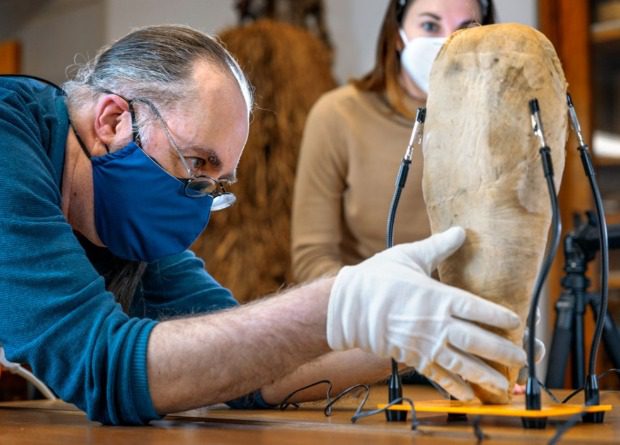American explorers studied the mummy of a bird, which was considered the remains of a hawk. It turned out that under the “cocoon” are the remains of a sacred ibis, which even partially preserved soft tissues and feathers. According to scientists, this find, which was kept in an educational institution for a long time, is about 1500–2000 years old. This was reported in a press release from Cornell University.
The ancient Egyptians mummified many types of animals, such as cats, dogs, hamadryas, and even beetles. If the main goal of mummifying people was so that they could exist in the afterlife (therefore, they put food, money, furniture and other items with them), then animals are believed to have been mummified for other reasons. Pets could be buried along with the owner, some animals and birds – as a supply of food for the afterlife, others – because people worshiped them. Some of the most famous mummies belonged to the sacred ibis (Threskiornis aethiopicus) – large birds that the ancient Egyptians identified with the god of wisdom, Thoth. So, only during excavations in the Sakkara necropolis, archaeologists discovered about 1.75 million of these birds.
In recent years, interest in ancient Egyptian animal mummies has increased. Moreover, it became possible to make three-dimensional reconstructions of their internal structure, without violating their integrity, using X-ray computed tomography. Human mummies are also actively studied by this method, for example, recently Egyptologists for the first time examined the mummy of Amenhotep I and found out that his remains were badly damaged by tomb robbers, and also enlightened two ancient Egyptian mummies from the “Valley of the Kings” (you can learn more about this monument in our material “Cache of royal mummies”).
Graduate student Carol Anne Barsody of Cornell University examined a supposed bird mummy that was in her school’s collection labeled as a hawk mummy. The exact origin of this artifact remains unknown, as there is no record of its arrival at the university. Initially, it was believed that this find could have ended up in the United States in 1884 along with the mummy of a man named Penpi, who was a Theban scribe during the Third Intermediate Period (c. 828–625 BC). However, Barsodi did not find any evidence for this, but suggested that perhaps the mummy of the bird was part of a collection from the Saqqara necropolis, which entered the university in 1930.
To make sure that the mummy was not a fake, Barsodi, together with the collection’s curator Frederic Gleach, decided to do an X-ray computed tomography. As a result of the study, they discovered that under the “cocoon” there are indeed the remains of a bird, which even has preserved some soft tissues and feathers. It turned out that one of the legs of this bird was broken even before it was mummified. In addition, after death (possibly during transportation), her beak was broken.
Ornithologist Vanya Rohwer examined the images and concluded that the mummy belongs to a male sacred ibis. In order for the remains of this bird to be folded in its current form, its thorax was removed and its head turned, which was not a common practice. The weight of the mummy turned out to be 942 grams, and its age, according to researchers, is about 1500-2000 years. Perhaps, if in the future it is possible to extract DNA from the soft tissues of this sacred ibis, then scientists will be able to determine the place where it comes from.
Photo: Explorer Frederik Glich with the mummy of the sacred ibis. Ryan Young / Cornell University









